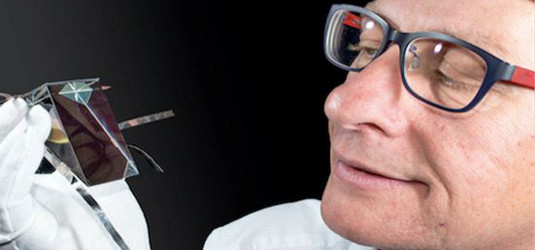Result by engineers at that University of New South Wales edges the solar industry closer to the theoretical limits of PV efficiency, smashing previous record of 24% set by Alta Devices of the U.S.
A new world record for unfocused sunlight-to-electricity efficiency, set by engineers at the University of New South Wales (UNSW) in Australia, has nudged the theoretical efficiencies for solar cells to greater heights.
Using a 28cm2 four-junction mini-module embedded in a prism, researchers Dr. Mark Keevers – UNSW senior research fellow – and Professor Martin Green – UNSW director – recorded a sunlight-to-electricity conversion efficiency of 34.5% by splitting incoming sun rays into four bands, using a hybrid four-junction receiver to maximize the amount of electricity extracted from each beam.
The result has been verified by the National Renewable Energy Laboratory in the U.S., and is another world record for the UNSW team, which in 2014 achieved a 40% electricity conversion rate using mirrors to concentrate the sunlight (CPV) and then split the various wavelengths.
What is striking about this latest achievement, however, is that normal sunlight was used, making the technique feasibly deployable in standard solar PV cells. The previous record using such a technique was 24% conversion efficiency, set by Alta Devices of the U.S., but over a greater surface area: 800 cm2 compared to UNSW’s 28 cm2.
Mini-module breakdown
The module used by UNSW to set this record-breaking efficiency is comprised of a silicon cell placed on one side of a glass prism, with a triple-junction solar cell on the other. The triple-junction cell is adept at targeting more discrete bands of incoming sunlight using three layers: indium-gallium-phosphide, indium-gallium-arsenide, and germanium. Each junction then extracts sunlight at its most efficient wavelength as it passes through, with un-captured light moving on to the next layer.
Parts of the infrared band of sunlight unused by the triple-junction cell bounces through to the silicon cell on the other side of the prism, thus ensuring nearly all of the energy from each beam hits the module. To scale up this mini-module to the size of 800 cm2, as used in Alta Devices’ previous world-beating test, is – according to the engineers – well within reach.
“There will be some marginal loss from interconnection in the scale-up,” said Keevers, “but we are so far ahead that it’s entirely feasible.” The researcher added that the theoretical limit for such a four-junction device is around 53%, so UNSW is already two-thirds of the way there.
“What’s remarkable,” added Green, “is that this level of efficiency had not been expected for many years. A recent study by Germany’s Agora Energiewende set an aggressive target of 35% efficiency by 2050 for a module that uses unconcentrated sunlight, such as the standard ones on a family home.”
The multi-junction cells used in UNSW tests are not likely to feature in mass-produced panels for a while yet due to the cost and effort required in producing them. However, UNSW researchers are also focusing on ways to lower production costs of such cells.
“Things are moving faster in solar cell efficiency than many experts expected, and that’s good news for solar energy,” said Green.
Results testament to Australian innovation
A consortium of organizations and agencies supported the UNSW’s research, including Trina Solar, RayGen Resources, NREL the Australian Renewable Energy Agency (ARENA), which spoke glowingly of the university’s success.
“Australia already punches above its weight in solar R&D and is recognized as a world leader in solar innovation,” said ARENA CEO Ivor Frischknecht. “These early stage foundations are increasingly making it possible for Australia to return solar dividends here at home and in export markets – and there’s no reason to believe the same results can’t be achieved with this record-breaking technology.
“It’s great to see UNSW is working with another ARENA-supported company in Victoria – RayGen Resources – to explore how the advanced receiver could be rolled out at concentrated solar PV power plants.
“With the right support, Australia’s world leading R&D is well placed to translate into efficiency wins for households through the ongoing roll out of rooftop solar and utility-scale solar projects such as those being advanced by ARENA through its current $100 million large-scale solar round.
“Over the longer term, these innovative technologies are also likely to take up less space on our rooftops and in our fields.”
This content is protected by copyright and may not be reused. If you want to cooperate with us and would like to reuse some of our content, please contact: editors@pv-magazine.com.








By submitting this form you agree to pv magazine using your data for the purposes of publishing your comment.
Your personal data will only be disclosed or otherwise transmitted to third parties for the purposes of spam filtering or if this is necessary for technical maintenance of the website. Any other transfer to third parties will not take place unless this is justified on the basis of applicable data protection regulations or if pv magazine is legally obliged to do so.
You may revoke this consent at any time with effect for the future, in which case your personal data will be deleted immediately. Otherwise, your data will be deleted if pv magazine has processed your request or the purpose of data storage is fulfilled.
Further information on data privacy can be found in our Data Protection Policy.